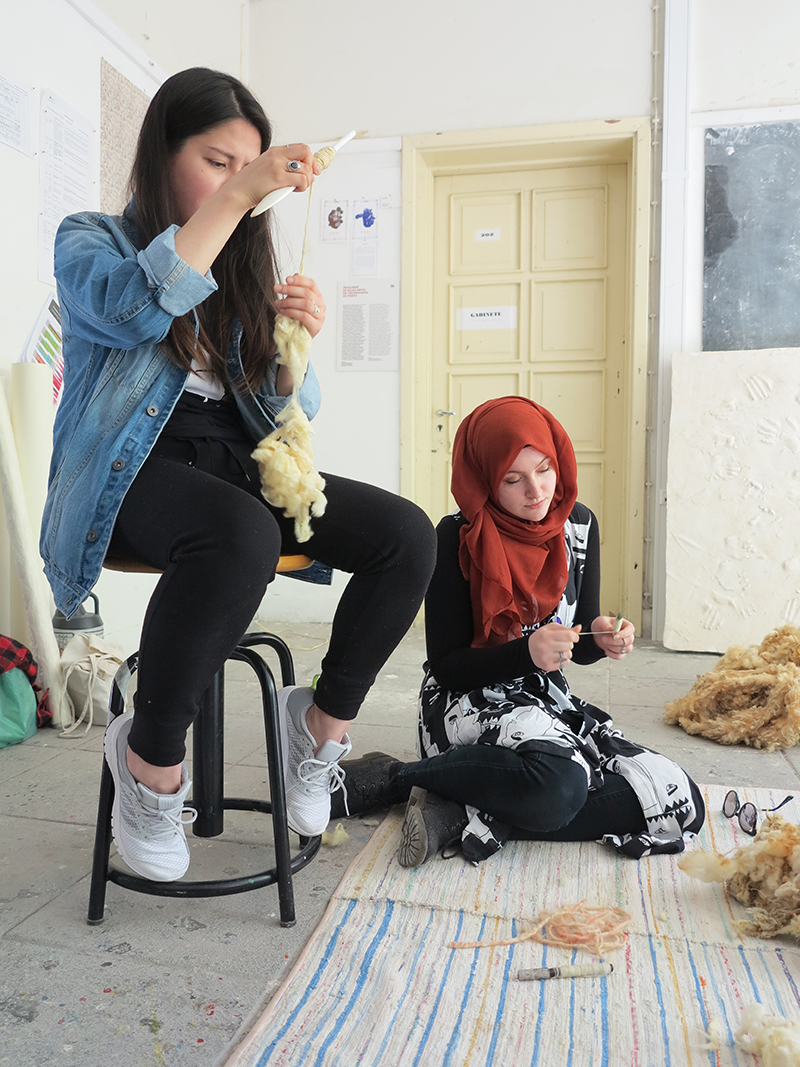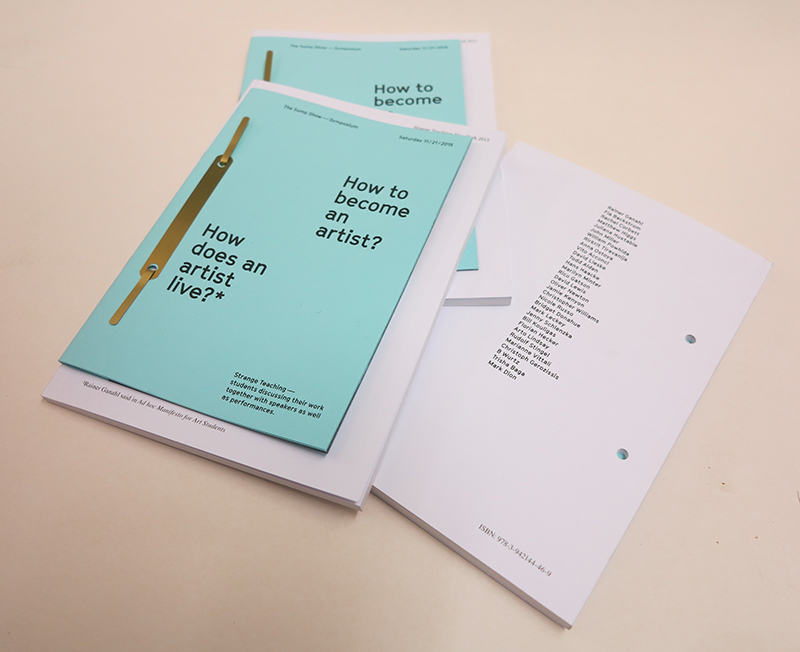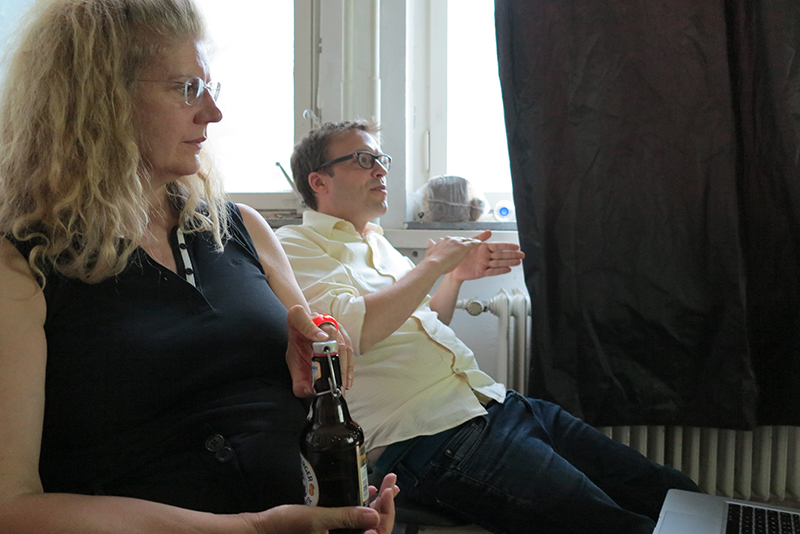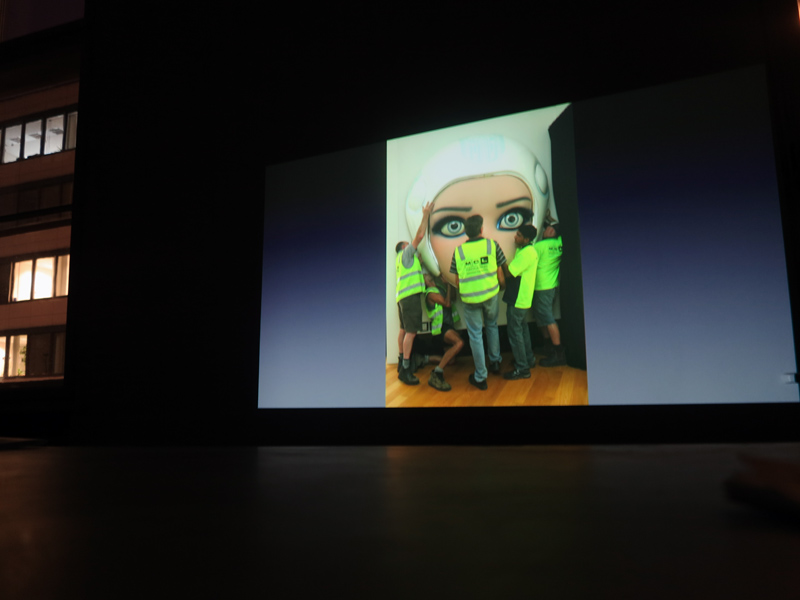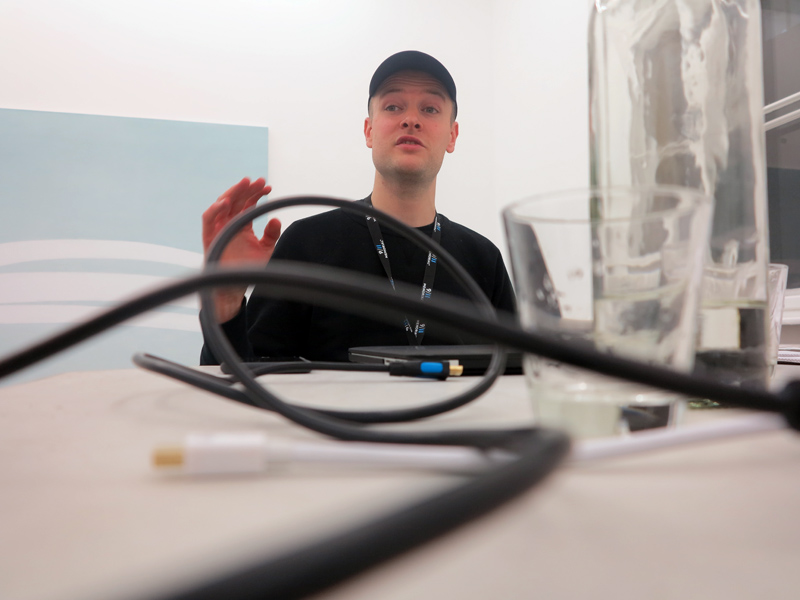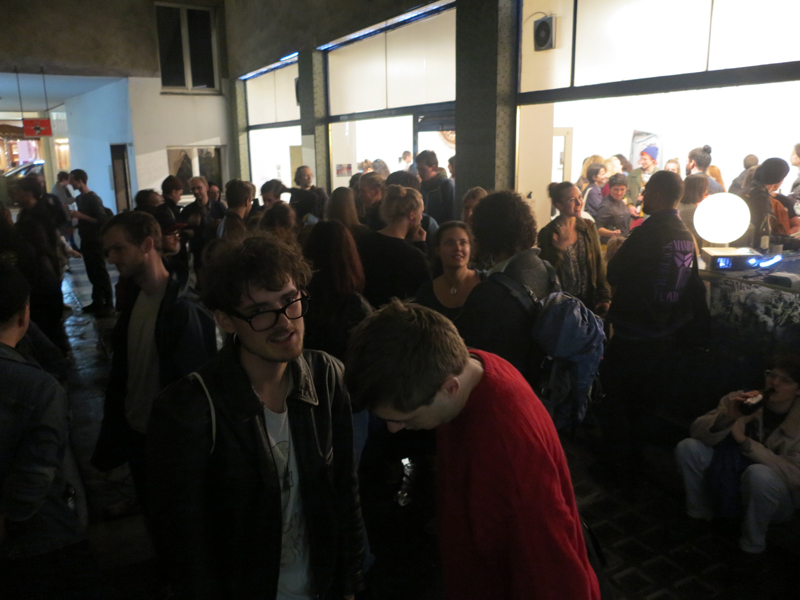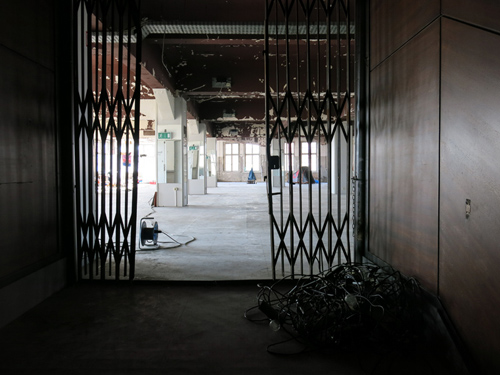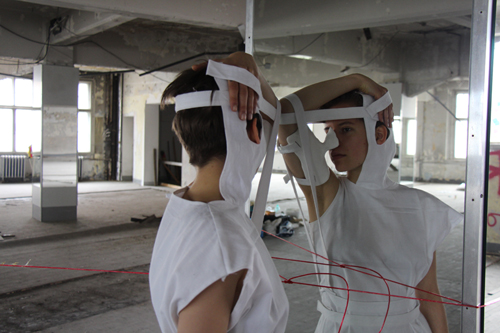STRANGE TEACHING
An educational extravaganza
please, follow us on instagram @strangeteaching
this account is different from my main teaching tool @strangeteachingart
note my main instagram account @rainerganahl
my main web site
rainer ganahl - text
What should art
education really be
in these days
since
it cannot
be just reduced
to telling people
to stop making art
STRANGE TEACHING – THE ARTIST AS EXCELLENT AND MISERABLE TEACHER
Why I stop buying the art works
of my students
STRANGE TEACHING - CONTRASTING VIRTUES
strange teaching
24 p pdf july 2015 a publication
contact me
press:
An artikel on Strange Teaching NY 2015 in the New Yorker
Strange teaching sees art education is not so much as the result of studio work in the proximity of one Professor Meister but as an ongoing never ending learning process that occurs between many people, in exchange of ideas and - most importantly - in a clear first hand understanding of why certain artists do what they do.
I want to thank everybody who participates in this planned and spontanious multi-level exchanges that all take place outside convential institutional and ecnomoical spaces and conventions.
The results can best be found on intagram with over 1200 15 second long video fragments and still images. you can few these results wihtout becoming a member by simply clicking here
----
Next: Bejing 2020 - contact for inquiries if intereted to participate as a strange teaching students
----
April 11 - 25, 2019
Tehran - Chambers d’amis
Exhibiting in friends' homes
TEHRAN / IRAN: Chambers d’amis / Exhibiting in friends homes, 2019
In April 2019 we opened camp in TEHRAN only weeks beforere the USA under president Donald Trump mobiled airport carriers, war shops, bomber squats in the Persion golf and withdrew personal from Iraq. - while writing, everybody is currently alarmed and civil air traffic over Iraq is asked to detour. We organized Chambers d’amis / Exhibiting in friends homes. This show MEMORIZES an importat EXHIBITION THAT TOOK PLACE IN BELGIUM IN THE 1980s. In the absence of any financial or institutional support we have to literally rely on local (Tehran) friends. A local host, an artwork, an artist. In total over 30 mini-exhibitios and lectures inTehran's private homes. In Iran, private space is the political. To quote an Iranian: "we used to drink in public, and pray at home - now we pray in public and drink at home".
TEHRAN was my second point of interest concernt the politics of and with students. In 1968, a student protest ended in a massacre in Mexico City and over 1000 people dead. 1979, In Tehran, another anniversary, a student protest changed not only the Iranian history but world history and that to this day. The incredible raise of the Saudi regime with their most poisonous interpretation of Islam - near all 911 attackers were SAudis and its financing as well: and so is the financing and insturmentalization of Wahabism, Saudis most consequential export of ideology and hatred - had not taken shape the way it did had Iran continued to work together the way it did with the west.
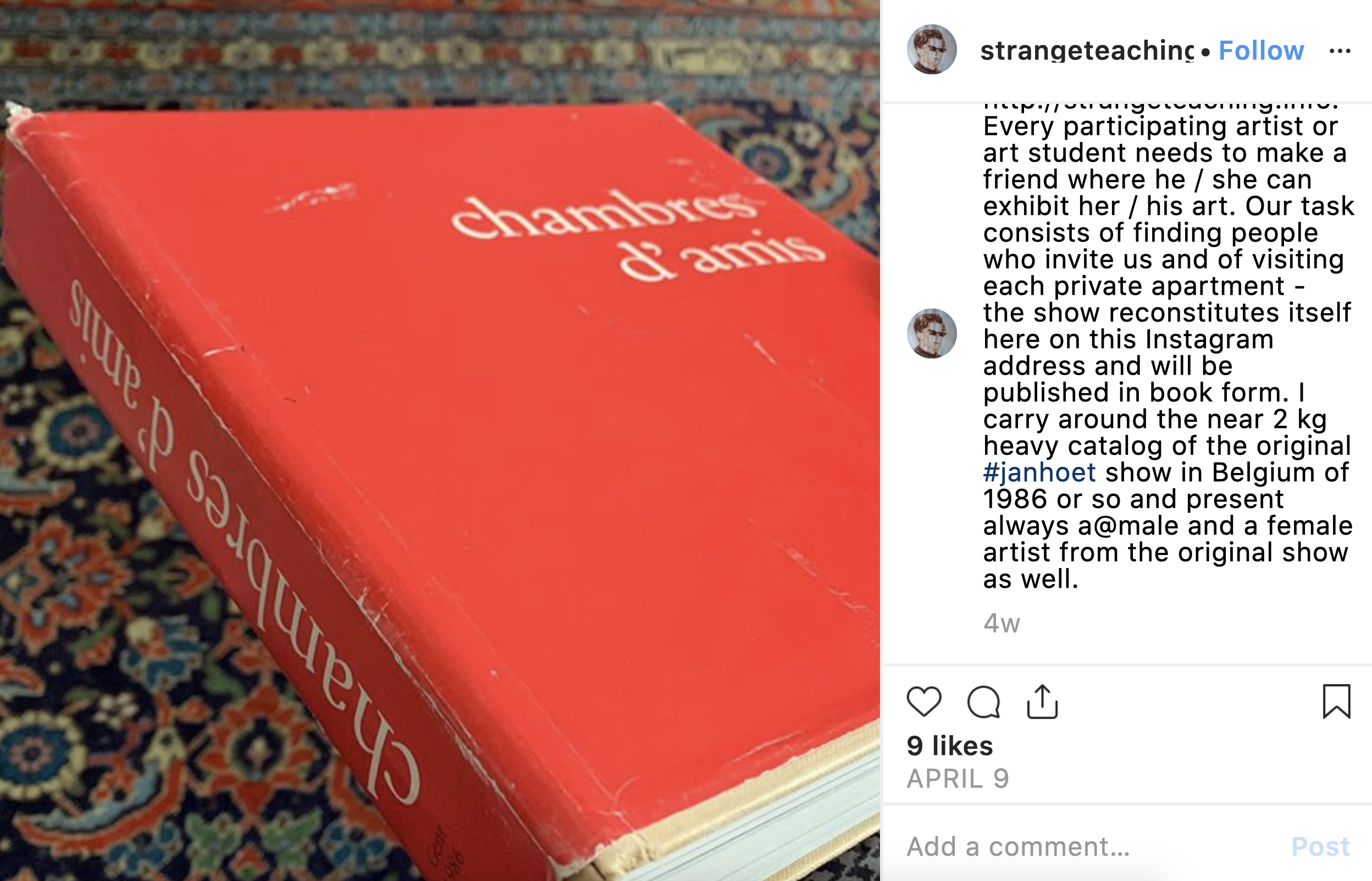
The route of friendship is running into a wall
Make Brutalism beautiful again
mexico city
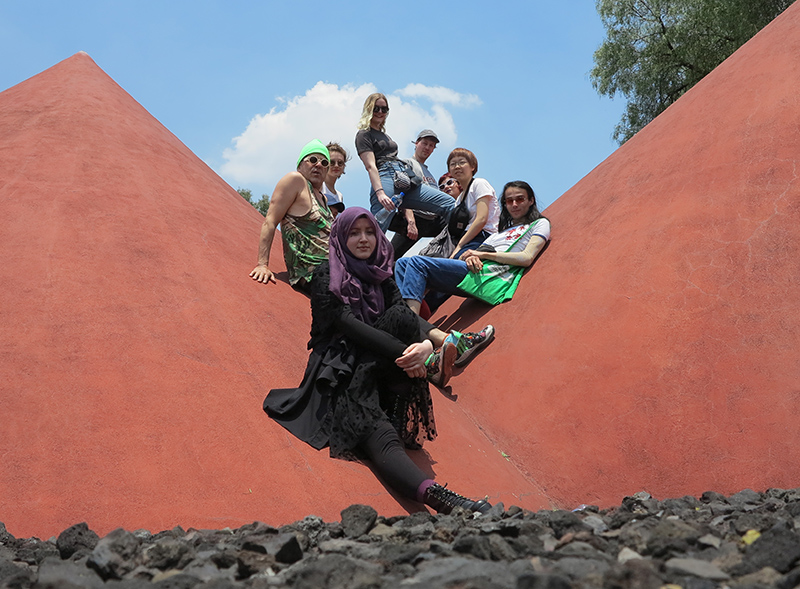
an
APRIL 15 - 30 2018, @ LADRON ---- MEXICO CITY
In 1968, Mexico City hosted the Olympic games which have been very important for the rapid urbanization of the city but the Olympics served as a stage for protests of student movements in Mexico and elsewhere. Running up to the games, a symbol of peace, the Mexican government massacred between 300 and 400 students, who were indiscriminately mowed down by government forces during prostest. Of social justice. Political tensions arose due to massive spending for the games and any resistance to improve the situation for labor and farmers. Far over a thousand people were arrested and countless people injured. To this day, there is still not much clarity and research or any kind of acknowledgement of guilt from the side of the Mexican government. The games are also remembered for the US athletes John Carlos and Tommie Smith, who greeted their Olympic medals with the Black Power Salute, a raised fist and a lowered head.
Mexico City also staged an ambitious international art exhibit with the telling name Route of friendship consisting exclusively of large concrete sculptures that where supposed to be colored and placed along a new highway rout leading out of the then smaller city. Today, many of these sculptures are still in place but have been absorbed by the city now unrecognized asking to hope for International friendship.
Hegel’s idea of historical repetition as a farce is proven right today once more, 50 years later, when racial tension in the USA are again in the open and expressed with Black Power symbols at sports events. Donald Trump, the most divisive president of the USA in many decades, is in the business of constructing a “big, beautiful wall with Mexico” and implements the exit from international trading deals that include Mexico and the rest of the world according to his “America First” logic.
As a new installment of my ongoing Strange Teaching project I will ask various students to take up the original idea of the route of friendship and place works made of concrete along a route to be yet determined. With no productions budget and no permits, artist-students are asked to install works clandestinely along a new route of friendship. The works should be also made of concrete, but have to remain unidentifiable, stealthy, absorbed by its regular surrounding, so it is not removed or sanctioned. It is the art of each participant to find a way to insert him or herself into public space through Mexico City. The artist run space, Ladron (Thief), our generous hosts for the duration of this process, will show models, drawings and documents of the process and the final works and organize some tours to the actual works in place. At Ladron we will also try to host lectures and improvised classes according to the logic of Strange teaching.
Given the international scope of the original projectI I try to invite students from various countries and art academies to join and re-work the very idea of a series of Friendship sculptures in a time of open chauvinist hostilities, new political formations of fascisms and a rejection of globalist views of an open world. The 1968 selection of participating countries appears random with Germany, Britain, Netherlands, and any Nordic Countries missing. From Central and South America, only Uruguay and Mexico participated with the host country executing even two projects. Hence, our group consisting of semi-randomly put together internationals will not attempt to regroup along national lines but rather along conceptual and artistic once.
Thus we will try to free THE OPTIMISTIC IDEA OF FRIENDSHIP AND HOPEFULLY RELEASE SOME OF THE ORIGINAL ENTHUSIASM already created on the very site of the 1968 Olympics resisting the new fascisms of the current world
please, note.. if you want the actualy SEE THE PIECES YOU HAVE TO SERACH THEM IN THE STREET
my own contribution in concrete
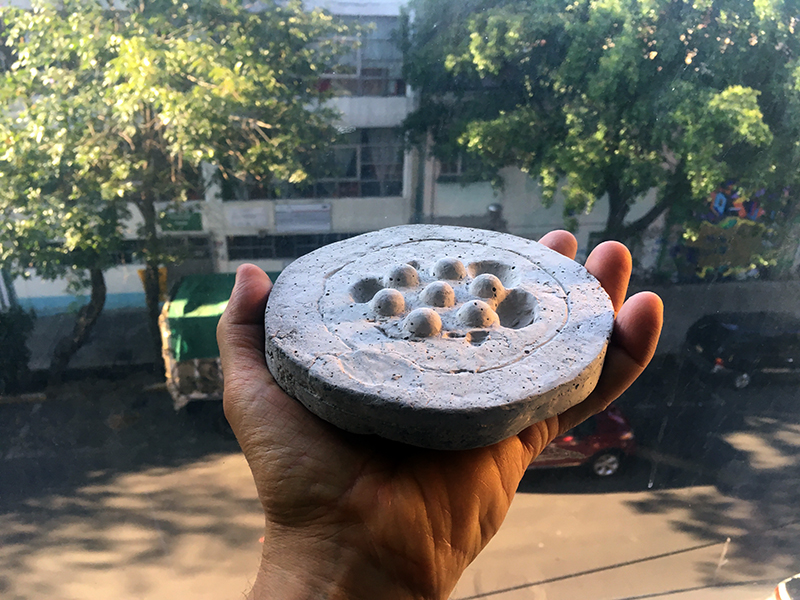
DRAIN STOPPER 1964 / 1967 / 1968, 2018s
related work made in Mexico
REPETITION, 2018 or see directly on youtube
Celebrating Brutalism, 2018 or see directly youtube
MANHATTAN MARXISM / WOOL WORKS / EXPLOITATION
STRANGE TEACHING /WOOL WORKS /EXPLOITATION
a project developed for PANORAMA BOA VISTA, Porto, Portugal, March 2017
How to become an artist ? How to live? New York 2015
NEW YORK, NEW YORK, 2015 @ THE SUMP TRIP
NOVEMBER 15, 2015 - NOVEMBER 29TH
with studentes from professors sending student of Heimo Zobernig, Olav Nicolai, Gregor Schneider, Jutta Koether, Natascha Sadr Haghighian
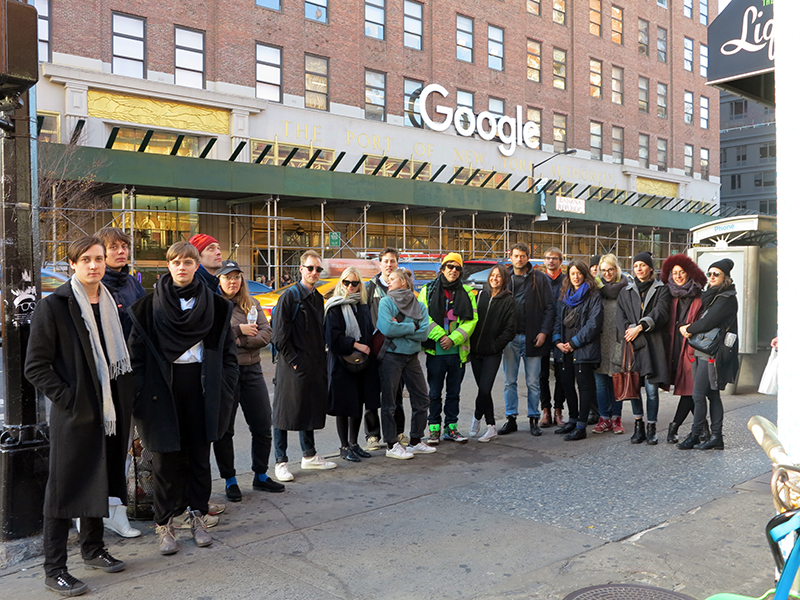
as usual - not everybody makes it in time on the spot wanted - here in front of the NY headquater of today's encountering
see link ( to be published soon)
An artikel on Strange Teaching NY 2015 in the New Yorker
STRANGE TEACHING - SYMPOSIUM - ALIENATION / ENTFREMDUNG
ABK-STuttgart, , July 2015
STRANGE TEACHING - ARMADA, MILAN, May 2015
Wave upon Wave of Invaders
The title reflecting the history of the world is written on an art work by Lawrence Weiner, entitled With the Wind, from 1989, which shows these lines written on a navigational chart. The politics of invading is basic to understanding why we have so-called world languages. The politics of invading also explains why the world is not a patchwork of myriads of belief systems but geographically divided by so-called world religions and large coherent political projections that are all competing with each other. The politics of invading is also the origin of our still current political order in Africa and the Middle East that is now about to be threatened and scattered into chaos after a series of invasions we remember all too well. The current crisis in the Middle East and large parts of Africa, due to ethnic, tribal, religious and political conflicts, civil wars and power struggles that all are again fed by forces from outside and inside over basically anything one can fight over, pushes people literally into the sea, into the winds of desperation and quasi-suicidal adventure. I am not going to elaborate here on politics that are so visible and noticeable everywhere but simply evoke another title of Lawrence Weiner’s that I find significant: Water does find its own level.
This exhibition brings together artists that take their first steps and those who have been on open sea for over half or at least a quarter of a century. I would like to point out that not only people travel but also gods, ideas and institution and practices. In that sense I would like to point out that I am on a self-made raft that is sailing under various flags and has one registered harbor at the State Art Academy Stuttgart. I’m also watching a compass that points to something I simply call Strange Teaching and is beyond our institutional coordinate system. I am also sailing with a pirate standard that lets me enjoy and suffer the songs and pains of sirens, hard winds and delusions. But I am also hanging here on a rope that is held by many others for which I am so thankful.
In this sense, I would like to thank Amy Lien, Enzo Camacho, Tan Cheng, gluck50, Armada, Lawrence Weiner, Nasan Tur, and all the many participants of this exhibition, which will for sure be very uneven but hopefully surprising.
Rainer Ganahl, New York, April 2015
armada milano · armadamilano.com · Milan, _ _ · Italy
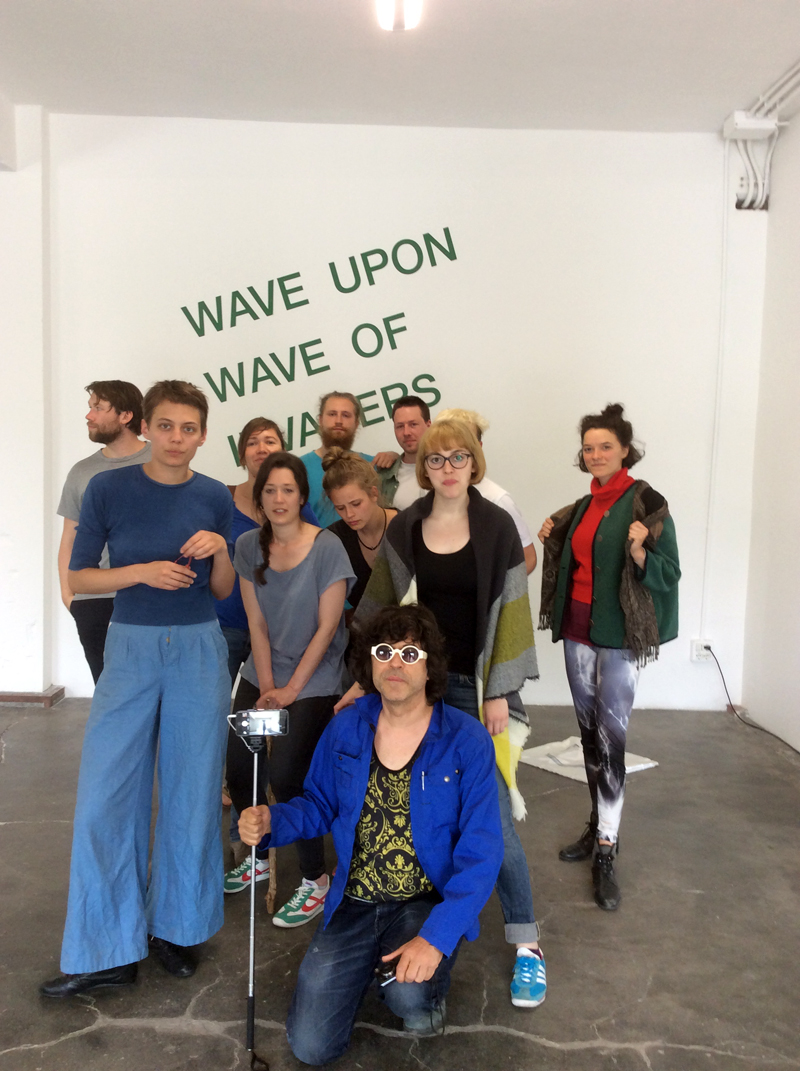
nearly everybody in front of LAWRENCE WEINERS title giving piece WAVE UPON WAVE OF INVADERS - which organized our show
See more here.
STRANGE TEACHING - ROB PRUITT FLEA MARKET VENICE, 2015
ROB PRUITT invited me to participate in one of his ROB PRUITT FLEA MARKETS for which he invites artists to sell their artworks. I took this invitation and passted it on to my students including one from the Academy Vienna, the class of Heimo Zobernig/Florian Reiter.
The event took place in the very, very exciting days of the Venice Biennial openings. Given the celebrity status Rob Pruitt enjoyes in New York City and elsewhere quite some celebrities came through looking around, shaking hands, buying stuff.
flea market attracted CELEBRITIES . below gavin borwn shaking hand and will all curators
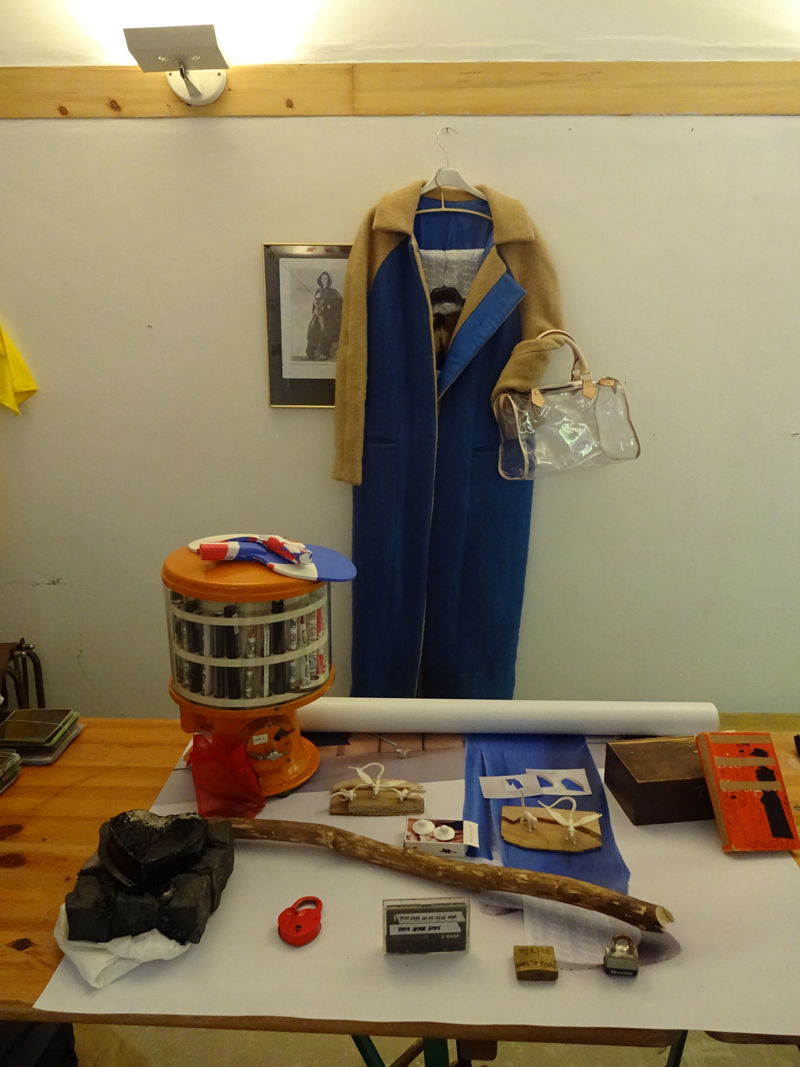
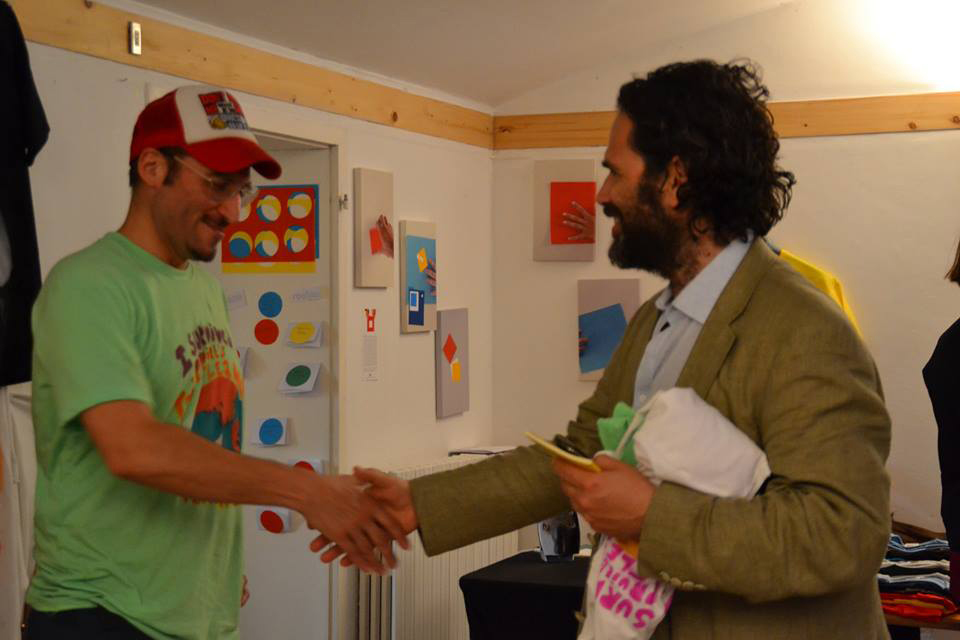 ---
---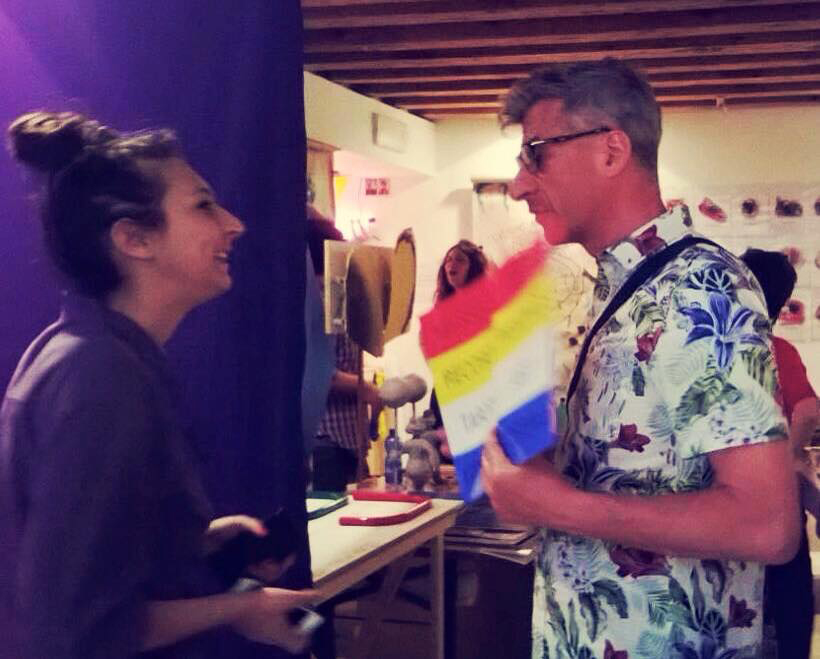
gavin borwn shaking hand with people: right: Maurizio Cattelan visiting and talking to one of the /curators
SEE MORE HERE
STRANGE TEACHING - Berlin, 2015
A teaching marathon - The Composing Rooms
Strange teaching took us to THE COMPOSING ROOMS in Berlin with an exhibitions that added a number of art students studying with Manfred Pernice, Josephine Pryde . It concludes a 10 day marathon of intense encounters with the following artists and ciurators ranging through various generations, a large variety of approaches and media : AA Bronson, Angela Bulloch, Karl Homsqvist, Saâdane Affif, Yael Bartana, Simon Denny, Daniel Herleth, Raphael Linsi, Gerry Bibby, Yngve Holen, Marco Bruzzone, Kaspar Mueller, Daniel Keller, Nasan Tur, Heike-Karin Föll, Ché Zara Blomfield, Jay Chung, Max Pitegoff, Calla Henkel, and Juliette Blightman.
STRANGE TEACHING - Vienna, 2014 - pagpe under construction
Bar du bois (ewxhibition space) Vienna - Soft Nepotism
EXHIBITION OPENING, VIENNA, @ BAR DU BOIS ( not a bar, an exhibition space called after a bar, a piece of wood)
More here
STRANGE TEACHING - Leipzig, 2014
Monads with windows - künstlerhaus Held
publication - download PDF
STRANGE TEACHING - Shanghai, 2013
BAZAAR - A site compatible project
publication - download PDF
STRANGE TEACHING - New York
A publication STRANGE TEACHING 2015
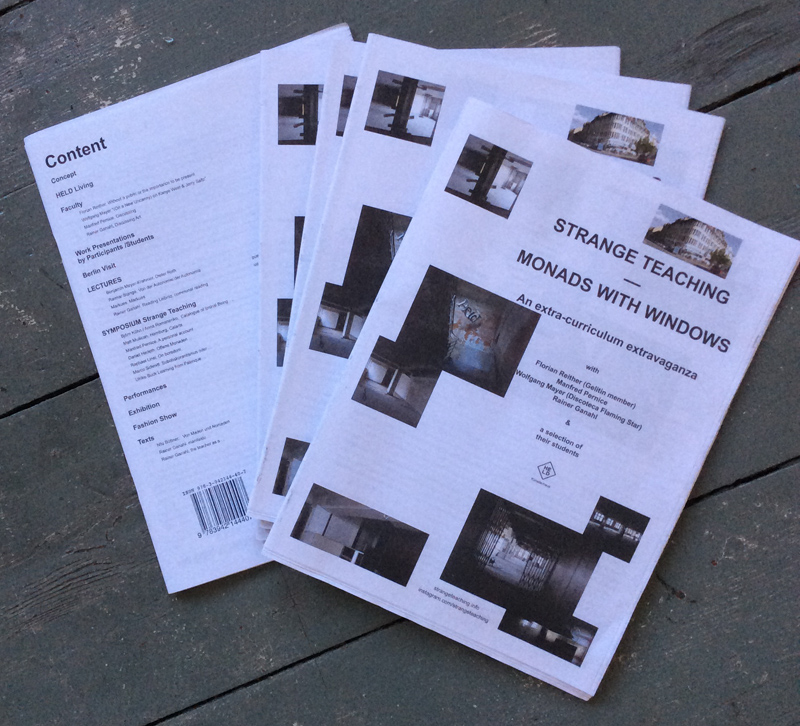
release party at the UdK Berlin, Klasse Manfred Pernice 2015 light was provided by a lamp, Manfred brought by
himself
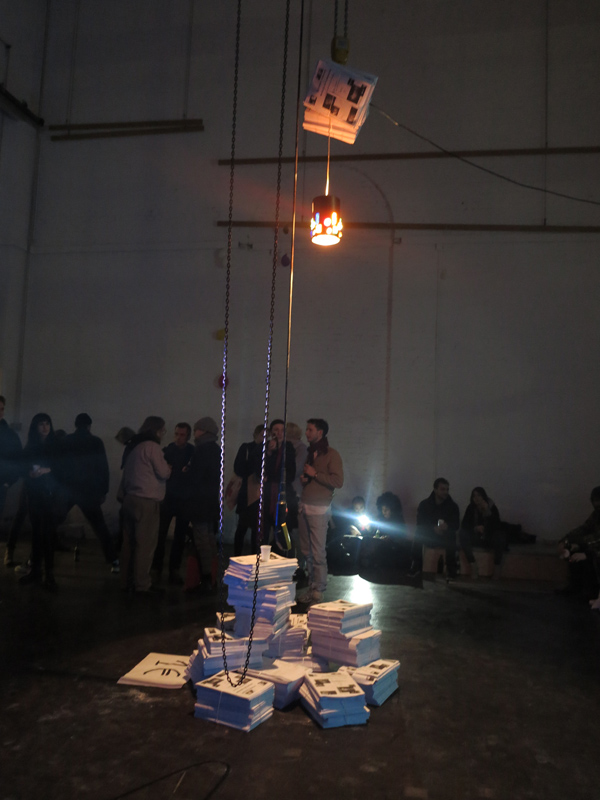
RELEASE PARTY STUTTGART SYMPOSIUM
BASIC TEACHING
Art Academy, Geneva, 1996-1998
abk-stuttgart, 2006 ff
see related educational projects by Rainer Ganahl
OUR EDUCATIONAL SECRET CREDO: FORCING STUDENTS INTO THE PROPER FORMAT ...
SEE how it is done
Strange Teaching, (After Herbert List's photograph 'Transplantation'), 1944/2014
... but Alfred Jarry is even worse: ALFRED JARRY STRANGE TEACHING (more of his work at hte very buttom of this page)
STRANGE TEACHING – THE ARTIST AS EXCELLENT AND MISERABLE TEACHER
When I first came into contact with art schools, their professors and teachers, I realized quickly that they affected students differently. My first art professor was Peter Weibel. I had recently graduated with a Master’s degree in philosophy and history from a regular university in Austria, where respect was gained in discussion through contributions based on knowledge and seniority. At my Viennese art school, attitude, social positioning and quasi-tribal politics ruled and respect was acquired through the proximity to professors and ruling art world VIPs. I couldn’t relate to any of that. I didn’t even understand their games properly. Being unable to adapt to these new art school hierarchies made me look something of an oddball to my fellow students. I soon got the impression that Weibel too perceived me in a similarly non-favorable way. All this eventually became unbearable for me. As a consequence I showed up only for the few occasions when Weibel gave a talk. But these few presentations by him and the reading of his own texts altered my ideas about art and helped me to reorient my interest and visual research. Weibel also let me look through Artforum, Flash Art and other current art‑journals and documentation which in 1985 were not easily available in Vienna. There was no internet and libraries did not offer foreign art magazines and articles in time. He taught me not only where to find information but also why something was important and relevant and why other things were not.
Weibel’s influence on my learning and understanding, despite the disharmony between us, was rather big. This stands in contrast to the experience with my next principle art teacher, Nam June Paik at the Academy of Fine Arts in Dusseldorf. He was a love affair for anyone who encountered him. He was funny, incredibly generous, helpful and he liked us all. But I felt I didn’t really learn more than what had been already communicated through his work and all books about him. I liked him and his art works a lot but he didn’t influence my perspective the way Peter Weibel had previously done. Weibel was very straightforward and people feared his opinions and judgment, something I needed at the time.
The next educational stop was the Whitney Independent Study Program (ISP). Coming from Europe in 1990, I entered into an intellectual climate at the height of a paradigm shift characterized by postcolonial studies and an orientation towards popular culture. The ISP repositioned my previous knowledge with respect to these new prerogatives and perspectives in a way that it still continues to mark my practice to this day. Investigating Euro-centrism and cultural arrogance, I could use myself as a good and readily available exemplar. I came to better understand myself and my biased cultural background, a process that is still ongoing, hence, I'm still unlearning. To this day, I am fundamentally marked by these educational experiences and I see or read nearly everything through these questions regarding representation and the dynamics of power. But again, it seemed that the more I learned from my teachers the less well I got along with them. There I had the honor to study with Hal Foster, Benjamin Buchloh, Mary Kelly, and Yvonne Rainer among others.
The reason for mentioning all these wonderfully fortunate though not always well ending encounters, is simply to show that one doesn’t need to get along with a teacher in order to learn something. Not to care about teachers is also consistent with my preferred autodidactic approach to education. This all should offer an explanation and an apology to why I tell students what I tell them, and why I am not so concerned whether they like me or not. I have had students quit because of my criticism or my disinterest. I do not think that Art School ought to be a client-oriented service station, seeking to make students feel good about themselves. The constant flux of networked Selfies and Likes can do that job better. I therefore define art education also as a clearing house that points towards the Exit door and hope to provide immunization for people from this virus
What should art education really be since it cannot be just reduced to telling people to stop making art?
I find it important to scare people out of this madhouse of false promises and irredeemable expectations. I welcome a negative attitude as part of an important component for any ambitious art education. In fact, I have learned most by people who trashed me when I started my way with writing and art making. Artists and poets live in a world of too much supply and only little if any demand to put it economically. and we have not yet even begun speaking of money. The chances for anybody in art school to come out and make a living or to succeed critically in the art world is very, very small. Speaking for myself in the role of a teacher, I encourage students to welcome disruption, obstacles and disillusions, confusion and surprises. 'd like to break early-adapted formulas and if necessary, to facilitate the exit or transfer out of art making. I offer non-sense and an insight into the miserable state of affairs; and finally push when the are about to fall.
I am perfectly aware I'm perceived as a good teacher by some and as one who is not worth his salary by others. These two opposite perceptions don’t even have to be seen as contradictory in themselves as they reflect just different degrees of interactions, expectations and demands. As mentioned earlier, I was learning the most from people I did not get along well, and those who made my life difficult. But I do consider it important to tell students what I think of their work, even if they end up disliking me and subsequently switch classes or even change school. I do have some cases in mind who looked for a more nurturing environment and found it elsewhere though soon after school they ended up as lost and alone with their work as before. Well, just face it, that is the life of an artist.
New York / Leipzig / New York 2014
Ad hoc Manifesto for Art Students
ONE
Do what you want to do, no matter what it is. Have fun.
TWO
Whatever you do, it should have something to do with yourself and with your own interests, and not with much else. There is no need to imitate professors, current art trends, anything chic or anything trendy.
THREE
Learn just whatever you need to know. Don‘t buy into the idea of learning some or many techniques first and then going on to do your own stuff. When you need to learn something, learn it by doing. If you don’t have anything to say, just don’t bother trying to say it. Be happy if you have to learn in an autodidactic manner. It might be even more promising, if the stuff of your interests is not offered in your art school. Saying this, I do not want to neglect all the great things art students can learn from regular art teachers and their work places.
FOUR
The social environment – including their faculty and visiting artists – one encounters on a campus is the most important thing an art school offers. Embrace it fully, but there is no need run after people ahead of you. Instead, work with the people who want to work with you and create relationships with whoever you can independent of their standing in the hierarchic pecking order of the given context. All good things derive from you and from the students around you but don’t expect much else. Organize yourself socially.
FIVE
Redefine success. Every work, every career looks different if it’s really worth the adventure. You have to define for yourself what you want, what you can handle and what you really need. You have to decide on your own, what success constitutes for you. Be aware of the difference between how you feel and see yourself and how you are perceived by others. Often, artists tend to easily fluctuate between exuberance, arrogance and depression.
SIX
Accept anti-illusionary education. Embrace a no-future situation. As a second-hand Lacanian might formulate it, love your wounds and keep offering what you can’t deliver. Education is love, love is education. Loosen up. Accept being a loser. Enjoy all the bliss.
SEVEN – Economics
Don’t depend on sales. Try to fix your economic basis otherwise. With few exceptions, artists who wanna succeed always find a way to get by somehow. If not, memorize Franz Kafka’s Hunger artist and recite it for money or move to Leipzig for as long as it remains dirt cheap. There is always a Brooklyn of the early 1990s, a Berlin of the last fifty years and a Leipzig of the current moment. Let's all meet in Odessa soon.
EIGHT
Art and the reception of art is a question of time. There are very few young artists who can cut it all short and hit some kind of jackpot at a very young age thought they may pay a price for it when prices are not sustainable and the downfall becomes graphic. The great curators, collectors, museum directors and art dealers of the future are most likely studying next to you and look all alike. It is normal to always feel voiceless, powerless, and in need of those who look like having it all. But ignore al this nonesense.
FINAL MUSIC - YOU GOT THE POWER …
Power is nonsense in the sense that it doesn’t exist by itself. It results from all participants in a given game, a given context. Power always shifts, travels, transforms itself and visit anybody who doesn’t give up ahead of time and capitulate. Today’s Macher, today's makers and shakers and great artists were yesterday’s students and most likely felt as irrelevant as art students usually feel when it comes to questions of success and power. There is no need to suck up to those ahead and disregard colleagues and peers who enter the circuit later. This self-defeating and unpleasant behavior is unfortunately the predominant style in the art world detectable already in art schools.
The best way to escape this trap is to organize things oneself and do it with one’s peers and friends. Students really shouldn’t be bothered with much else but their own practices and activities because only if they manage to connect with themselves and their own generation will they be able to take over from those ahead of them. Every generation will create their own stars and find somebody to fill the role of the curator, collector, art dealer. Anybody might play a role in this vast network of whispers, opinions, and up-and-down mouthing that so much influences all these various decision-making processes that we feel so dependent upon. The wheel of generational succession will never stop turning.
HAPPY END
The bigger the frustrations, the boredom and ignorance of what people define as successful art, the better and easier it is to break in with better, different and more exciting art. Hence, we don’t need to complain anymore. Lets just be really happy and celebrate the fact that there will always be amazing art works made. Their time will come.
New York / Leipzig / New York 2014
www.strangeteaching.info.
